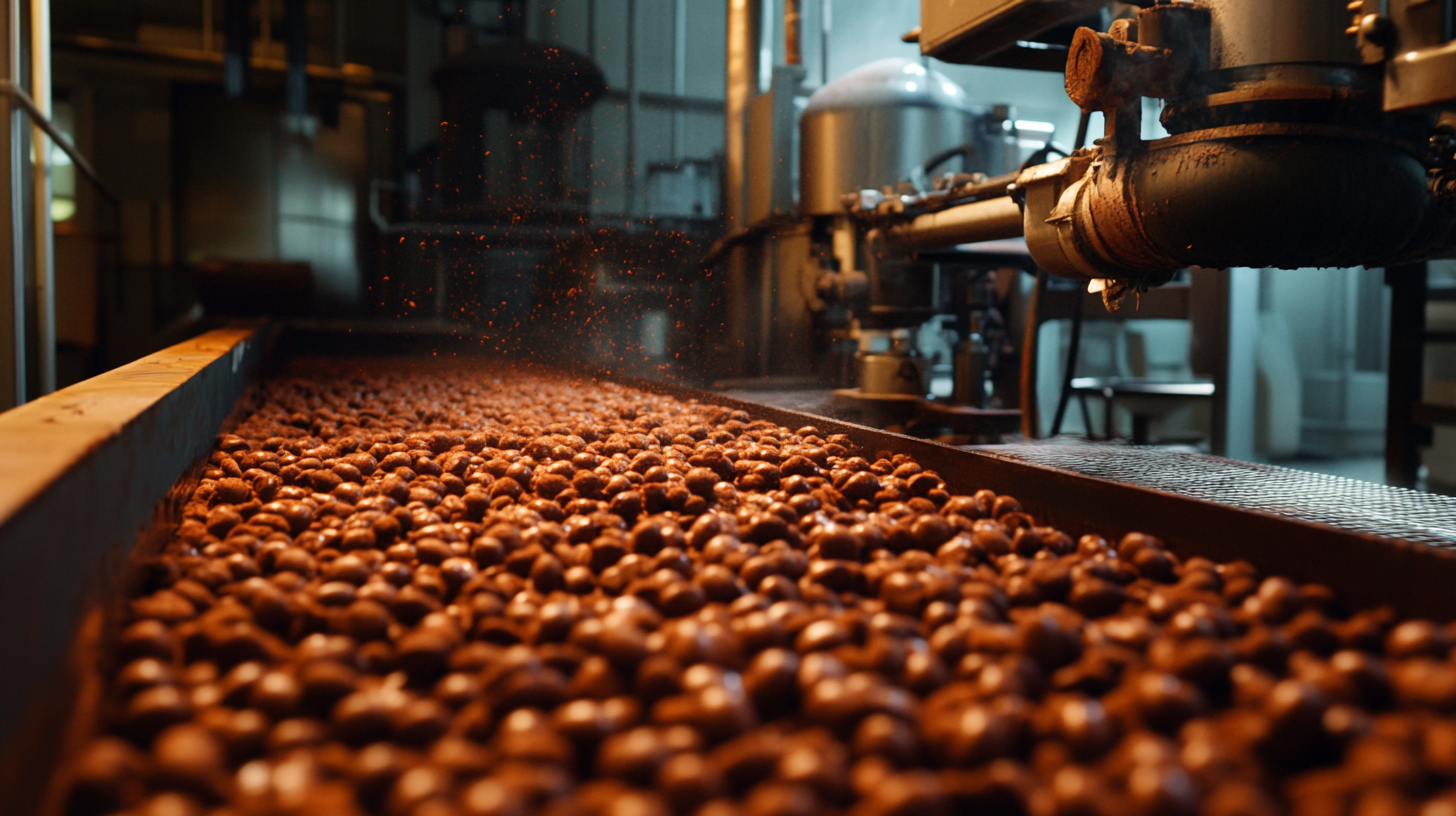The chocolate industry is transitioning through an epoch-making phase in the name of maximizing efficiency and productivity. While customer needs and preferences continue to change from one demand to another, chocolate manufacturers are beginning to adopt different innovative techniques to boost the efficiency of their processes. In the center of this transformation lies the Chocolate Production Machine, which has attained an essential aspect in refining the processes while assuring product quality. By adopting recent technologies and efficient practices, producers can reduce even the smallest amounts of waste and downtime while maximizing output.
We will consider several factors and innovative methods that can be considered innovative or novel in chocolate production machinery. These innovations cover automation, implementation of smart technologies, and methods of optimization, thus facilitating maximum efficiency in the production system. These innovations are put in place to better cater to market demand and provide manufacturers with more of a competitive edge in a highly one-dimensional sector. Let's join the blog and flicker the horizon of chocolate production by unearthing the groundbreaking practices that define the new standards of efficiency and quality.

One of the most significant breakthroughs in the advanced chocolate-making industry is the drive toward automation as a strategy for increasing output and reducing waste. According to the latest report by the International Cocoa Organization, the market for chocolates is anticipated to shoot to $161.56 billion by 2024, and this indeed makes the case for a need to constrict the operations of manufacturing plants. For companies, improved efficiency through the application of automated systems enables them to boost production without sacrificing their quality. The main advantage of automation near chocolate production is an optimization toward the resources managed. According to food and agricultural organization data, half of the automated production lines in use may save up to 30 percent wastage. Such wastage can only be reduced and made less expensive by satisfying the increasingly growing consumers' demands for better environmentally sustainable practices in food development. Several techniques have been employed in this regard, including hiring systems for specialized dosing and real-time ingredient flow measurements and controls to ensure that each ounce of raw material is used well rather than wasted. The introduction of smart technologies into chocolate production, such as IoT and artificial intelligence, will produce significant dividends. Automated machinery that has intelligent analytics built into them can forecast when they will require maintenance. This minimizes downtime and helps boost overall productivity. According to Research and Markets, an increase of 20 to 30 in overall productivity could be achieved through automation in manufacturing operations. This makes production scalable and efficient enough to meet the ever-increasing consumer demand without compromising quality.

As the name implies, IoT integrates with chocolate production, propelling forward the light of efficiency and quality assurance. Manufacturers, connected with Production IoT devices, monitor equipment performance and product quality in real-time on the entire production line. This allows for immediate response to changes, cutting down operational costs associated with downtime, repairs, and wastage of empty choco shell. Sensors also measure temperature, humidity, and, to some extent, viscosities of chocolate mixtures, allowing for tighter control of the entire production process.
These codes essentially permit predictive maintenance of equipment, highly reducing unforeseen risks in case of equipment failure. Using data taken from the machines, the manufacturers would know when to expect impending faults even before they manifest into failures. This, therefore, contributes to a paradigm in preventive maintenance, which extends the life of the maintenance program to include not interfering with production schedules. Real-time analytics allow for phone-based intervention in decision-making wherever a production strategy needs optimization with live data inputs.
Employment of IoT in chocolate production does not merely increase efficiency; it also increases transparency and traceability. Manufacturers can have extensive data about the complete life cycle of the product, starting from raw material sources and going all the way to the end product delivery. This transparency not only enhances quality assurance but also creates greater customer confidence in the product. IoTs' acceptance into the chocolate business is indeed a paradigm shift toward the manufacturers who want to remain competitive in a fast-revolutionizing market.

Energy efficiency has come to be vital for cutting operational costs in the chocolate production process. This has to be done without yielding its quality. Optimization of production processes through machines with innovative technology is an effective way to improve energy savings. These new machines will have smart sensors that monitor machinery performance and energy consumption in real-time. Using data from these sensors, the manufacturer then makes changes that help to align energy usage with production needs.
Another innovative approach to energy efficiency is the use of optimized automation systems. These systems further streamline production and reduce the wasted energy emissions through the entire workflow. With anyone considering the use of programmable logic controllers for synchronization between various stages of production, the downtime will be less, and peaks will reduce as far as energy consumed is concerned. This synchronization reduces energy cost by high rates without compromising on production efficiency.
Regular maintenance of machinery used in chocolate production works well in saving energy. Effecting a proactive maintenance schedule for manufacturers allows them to have an early warning capability with respect to potential issues before they become very costly causes of inefficiencies. The routine checks, timely upgrades, and improvements ensure that the machines work to their best efficiency and that they last longer. This, in turn, brings about massive savings as far as replacement and repair costs over time are concerned. Such energy-saving practices provide a firm foundation for achieving sustainability, and therefore, chocolate producers will not find it easy to thrive in an increasingly difficult environment market-wise.

To ensure uncompromised quality and reduced costs while maximizing machinery efficiency, the chocolate production sector is in competition with other industries. Predictive maintenance is one of the most innovative developments that have come along and it corresponds to the management of the equipment lifetimes of production assets. Production equipment can be monitored using advanced data analytics techniques to acquire an anticipated failure point before it occurs, thus allowing timely intervention to avert unplanned downtimes.
Which involves the collection and analysis of data coming from machinery sensors in real-time performance monitoring. Most of these proactive techniques aim to detect wear damage but also allow much better maintenance scheduling, which leads to much more improved diagnostics based on actual equipment usage. It denotes applicative strategies on chocolate production machines, where precision is paramount, as this ensures that the machine has been operating within suitable parameters, safeguarding the quality chocolate.
The cost-benefits of implementing predictive maintenance are many. By performing redundancy maintenance and preventing major breakdowns, chocolate manufacturers can better optimize their resources. Also, this shifts the maintenance schedule from reactionary to proactive, which not only improves productivity but makes the production environment more sustainable for the consumer as well as producers. Thus, with such a change in maintenance culture, when the industry is moving towards evolution, those adopters who embrace predictive maintenance technologies will have an edge over others who do not.
Manufacturing of chocolate, as it pertains to an agile method, is becoming mandatory for all chocolate manufacturers who want to speed up product development. That's what they need. Not just products but processes and teams are getting faster. Engaging producers in agility will have them on their toes with market trends, including the marching rise of the more health-demanding consumers with 100 percent chocolate, no added sugar.
Supposedly, recent advances regarding cocoa beans processing, and more so, about severe roasting, yield an advantage; for it mitigates bitterness thereby leading to palatable health-oriented chocolate produced from consumer angles. The advantages could be beneficial for companies with interest in productivity improvements in production because flavor profiles may be improved in their offerings through such roasting.
Also, more incubators for research and development have been established to show that the chocolate industry continues to promote ever-new ideas in chocolate innovation. The facilities were meant to propel such ideas into agility and probably beyond new frontiers in chocolate production. Such revolutionizing of age-old techniques could acquire for manufacturers more flexible, greener, and more interesting products catering to the contemporary consumer. Introducing such innovative route within the ambit of agile frameworks promises an exciting future for chocolate manufacturing, opening up flourishing pathways into ranges beyond satisfying the palates of current consumers, indeed setting new ranks in the industry altogether.
For more information, fill out our contact form